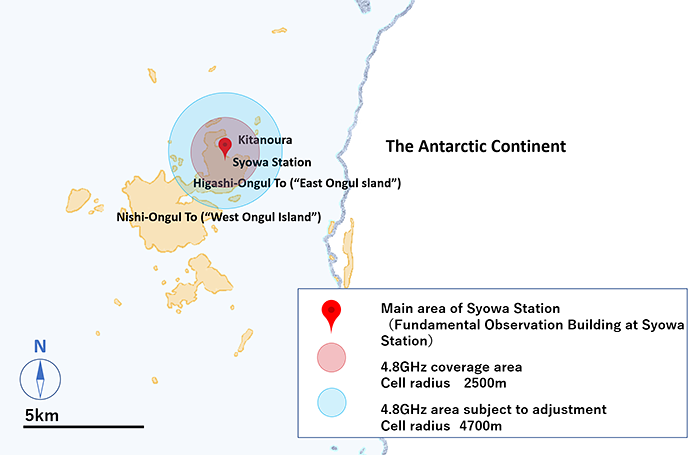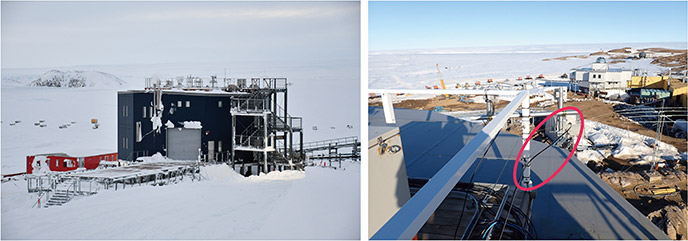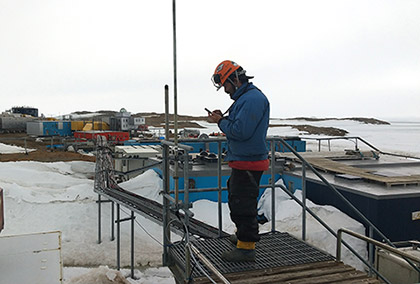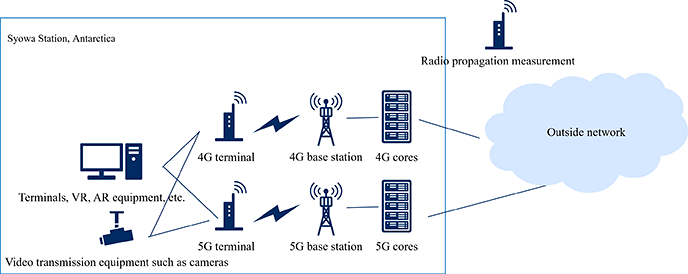National Institute of Polar Research
First demonstration of private 5G at Syowa Station in Antarctica
February 25, 2022
National Institute of Polar Research, Research Organization of Information and Systems
NEC Networks & System Integration Corporation
The National Institute of Polar Research (Director: Takuji Nakamura, NIPR) and NEC Networks & System Integration Corporation (Head Office: Bunkyo-ku, Tokyo, President: Yushi Ushijima, TSE: 1973, NESIC,) have begun demonstration tests of mobile radio communication systems utilizing private 5G, referred to as “Local 5G” in Japan, as a joint industry-academia collaborative study aimed at the “smartification” of Syowa Station, Antarctica.
In December 2021, the 63rd Japanese Antarctic Research Expedition team (Leader: Shuki Ushio, JARE63) arrived at Syowa Station, and began installing private 5G facilities as part of preparatory work for wintering. Preparing for installation was almost completed by the end of January 2022, and with the start of wintering in February, we began testing and operating the world’s first private 5G system in the Antarctic region.
Since the establishment of the Intelsat satellite communications facility at Syowa Station in 2004, we have been able to constantly transmit observations and use the internet via cable connections. Now, we can use Wi-Fi in the main rooms of the station. On the other hand, when outdoors, transceivers have been almost the only means of communication. During this demonstration, private 5G communications using smartphone terminals, etc. can be performed even outdoors.
Since 2020, NIPR and NESIC have been conducting joint research aimed at the smartification of Syowa Station. This study aims to improve the outdoor communication environment around Syowa Station, which has conventionally been restricted to communication using transceivers, and to construct a large-capacity, high-speed, and wide-range data communication environment, thereby improving the efficiency of the scientific observation activity by video communication and various applications, as well as improving the safety of JARE members.
Outline of the Private 5G Demonstration Experiment at Syowa Station
A private 5G base station facility has been installed on the roof of the Fundamental Observation Building at Syowa Station to conduct demonstration tests using private 5G on Higashi-Ongul To (“East Ongul Island”), where Syowa Station is located, and on the sea ice in the vicinity.
Figure 1 shows the estimated range of radio waves arriving from base stations installed in the Fundamental Observation Building. We will conduct video relays utilizing broadband low-delay circuits, which are characteristic of private 5G, and conduct remote monitoring of base facilities in the main area of Syowa Station, and on sea ice centered in Kitanoura (“Northern Cove”), to improve the safety of JARE members and test applications for reducing workloads. We will also evaluate the impact of 4.8GHz-band radio waves used in private 5G on observations at Syowa Station.
■Demonstration experiment period: December 2021 to January 2023 (JARE63 wintering period)
■Details of the experiment:
・Construction of private 5G, private BWA (*1) and sXGP (*2) systems and radio wave propagation tests
・Testing video relays from the field
※1 private BWA: A communication system for 4G used in a particular area
※2 sXGP: 4G based communication system for private communications

Fig.1: Assumed coverage area of the Syowa Station Private 5G Base Station. It covers almost the entire area of Higashi-Ongul To where Syowa Station is located.
Syowa Station Private 5G Base Station
The private 5G base station was installed on the roof of the Fundamental Observation Building at Syowa Station. (Fig.2). Since the 4.8GHz-band radio waves used in private 5G are excellent in rectilinear travel, they were set up so that private 5G servicing can be used over a wide area of the station by installing them in a building with good visibility in the main part of the station.

Fig.2:
Left: Fundamental Observation Building (photographed in July 2021). The antenna of the base station was installed on the roof of this building.
Right: Base station installation status (area enclosed by red oval)

Fig.3: A member of JARE operating a smartphone outdoors in Syowa Station and using private 5G communications
Private 5G Networks as Information and Communication Infrastructure at Syowa Station
Mobile terminals used for demonstration tests can be used as information communication terminals among the crew, including outdoor video transmission, through private 5G networking. Furthermore, by connecting to the Internet via the Syowa Station Network and satellite communication lines, we plan to be able to use a variety of services, including support for remote observation from within Japan.

Fig.4: Conceptual diagram of private 5G demonstration test configuration at Syowa Station, Antarctica
Future Development
Based on the results of this demonstration experiment, we plan to advance the large-capacity, high-speed, and wide-range data communication environment at Syowa Station and promote the smartness of Syowa Station by utilizing advanced technologies. It is expected that this will lead to the advancement of Antarctic observations in a variety of ways, including monitoring and remote control of station facilities, ensuring the safety of JARE members, communications, and controlling observation equipment and new observation methods.
Research Members
Masaki Okada (National Institute of Polar Research)
Kazuo Higuchi (National Institute of Polar Research)
Shinichiro Kugimitsu (NEC Networks & System Integration Corporation)
Toshikazu Harazono (NEC Networks & System Integration Corporation)
Hajime Oishi (NEC Networks & System Integration Corporation)
Akira Takayama (NEC Networks & System Integration Corporation)
Morikatsu Matsuo (NEC Networks & System Integration Corporation)
Kazuhiko Oda (NEC Networks & System Integration Corporation)
Engineering representative at Syowa Station
Kazutaka Mitsuno (63rd Japanese Antarctic Research Expedition wintering team)








